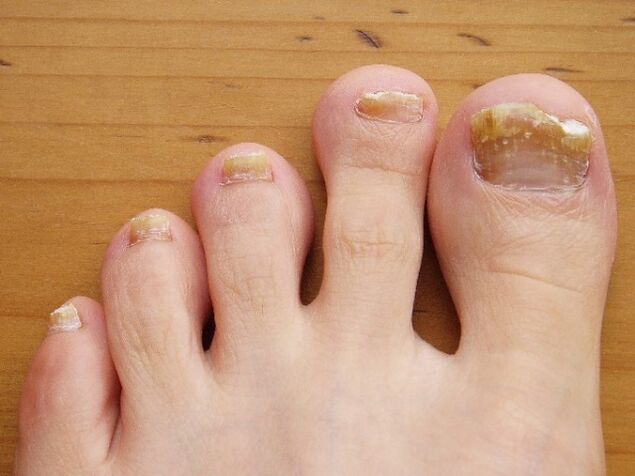Nail fungus or mycotic disease of the nails and tissues of the hands and feet is a common infectious disease. It is caused by yeast fungi that destroy nail plates and cause skin inflammation. In medicine, these diseases are called onychomycosis or paronychia. The standard misconception is that people who only keep their hands and feet clean can get the fungus. Nail fungus often affects those who have to stay in shoes for a long time due to the profession or other conditions.
Symptoms
The classification of the disease depends on the type of infection and the localization of its spread.
- Normotrophic onychomycosis manifests itself with small changes in the structure of the nail plate in the form of yellow spots and streaks along the nail. It is the least noticeable and often does not cause any discomfort. The main concern is the appearance of the nail, which people initially try to hide with the help of cosmetics.
- Hypertrophic onychomycosis causes an increase in the volume of the nail plate. A person with this disease may feel pain when pressing on a finger. This is a nuisance when walking in shoes.
- The surface of the white fungus is characterized by roughness and unpleasant whitish spots on the surface of the nail plates.

A mycologist who specializes in fungal diseases can determine the cause of the disease and prescribe the right treatment.
Types of mushrooms
The symptoms of a fungal infection are similar, but the doctor will choose the treatment depending on the type of fungus that is causing the disease.
- Dermatophyte is the most common fungus that causes damage to the nail plates and surrounding tissues. Usually chooses the skin between the thumb, little finger and fingers. It is easily treated with early diagnosis
- Candida begins to move on the skin between the fingers and moves towards the nail.
- Fusarium and Alternaria molds are rare and occur mainly in people with weakened immune systems
Reasons for appearance
The main cause of infection is a violation of sanitary norms. However, a person who carefully monitors the cleanliness of his hands, feet, and belongings can become infected in such common areas.
- Contact the carrier of the fungus and its belongings. This could be a visit to the bath or sauna, the use of individual outdoor accessories, or poorly designed manicure items.
- Excessive sweating of the feet creates favorable conditions for the spread of the fungus.
- The use of tight and poorly ventilated shoes made of artificial materials contributes to the formation of high humidity, contributes to the development of the disease.
- A weakened immune system cannot fight infection.
- Antibiotic treatment weakens the immune system and breaks down the body's own microflora.
- Long-term use of antibacterial agents that kill beneficial bacteria along with those that cause the disease
- Diseases of the vessels of the extremities reduce resistance and allow the fungus to disrupt the integrity of the skin for the development of the disease.
- Manifestations of diabetes mellitus in the form of skin disorders are a good environment for the development of fungal colonies.
- Wounds on the skin and cracks in the nails help the fungus to settle and start working.
- Visiting nail salons can lead to the appearance of fungal infections if the sanitary standard for the use of tools is not followed.

In children
Fungal infections are less common in childhood. This is due to the characteristics of the organism. As you know, children's feet are not subject to excessive sweating. However, going to swimming pools and gyms can cause infections in children. Weakened immunity with a cold also helps. There is also a risk of fungal infection during adulthood and adolescence, when the child's body undergoes rapid hormonal changes. To protect against infection, shoes should be inspected for cleanliness and washed with antiseptic compounds in a timely manner.

One of the causes of infection with a fungus in children may be a lack of vitamins in the body. It is desirable to fill the gap with the help of proper nutrition and complex vitamin therapy. A doctor's consultation will help you choose a quality vitamin supplement for your child.
Development process
Favorable conditions are needed for the development of fungal infections. Sweat-soaked shoes and a neutral or slightly acidic environment provide comfort for fungal growth.
Unpleasant appearance of nails, itching and pain around the nail indicate the onset of infection. If left untreated, after a while the fungus will completely destroy the nail plate and reach the soft tissues of the fingers and toes. In the advanced stages of the disease there may be qualitative changes in the form of blisters filled with a cloudy liquid with a strong unpleasant odor.
Complications
A common disease on the outer surface of the nail plate may not be a cause for concern. In some cases, this situation can last for years. The fungus carrier itself does not suffer, but can transmit the infection to others.
The consequences of an infection with a fungus primarily affect the nails and tissues around them, but can have negative consequences for the health of the whole body in the future.
The growth of fungal colonies causes pain in the feet and makes it difficult to wear shoes. Nails change shape and can grow up to the tissues of the fingers, causing unbearable pain when walking.

Deterioration of the immune system caused by toxins secreted by fungi throughout their lives often leads to colds and inflammatory processes in the body.
Allergic reactions to the products of the fungus cause a number of side effects of the respiratory system and liver and kidney disease.
An infection in the body can cause conjunctivitis, rhinitis of various etiologies. Itching, red spots and irritation on the skin can spread not only to the initial localization of fungal colonies, but also to the body and scalp. It also affects the condition of facial hair and skin. Dandruff may be part of the cause.
Persistent itching and discomfort caused by the disease is a fairly common reason to visit a neurologist and psychotherapist.
The advanced form of the disease can lead to nail loss and deformity of bones and joints.
Prevention
In order to prevent infection, it is necessary to carefully follow the rules of hygiene not only in public places, but also in private places.

It is forbidden:
- Use general hygiene products. Each family member should have their own nail clippers, handkerchiefs, soap, etc. should be.
- You can't use someone else's shoes. Infection can be easily spread through shoes shared in the family.
- Wash the patient's belongings together. Keep in mind that not all detergents and detergent compounds are capable of destroying fungi. This infection is very resistant. A sick person's clothing should be treated with special solutions. This is especially true for shoes. The inside should be thoroughly washed and the insoles changed frequently.

























